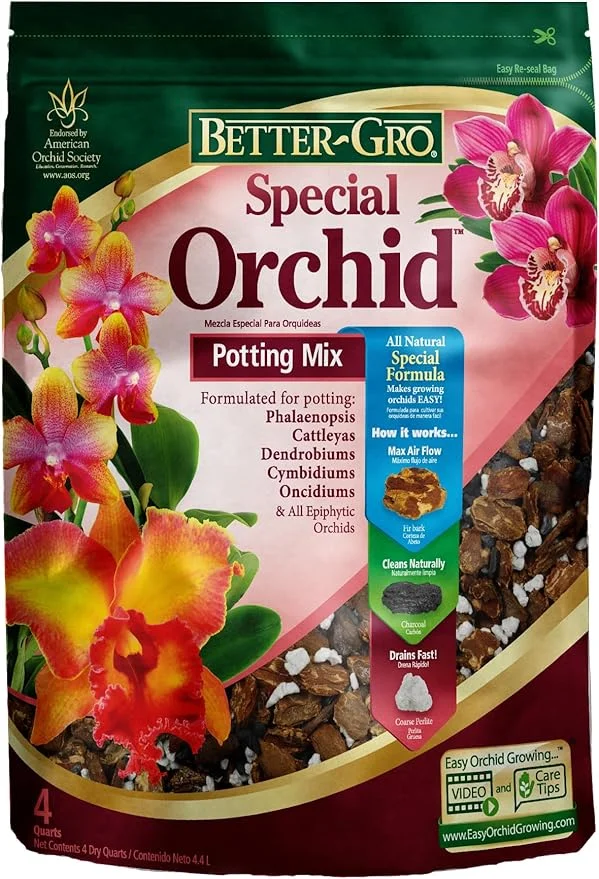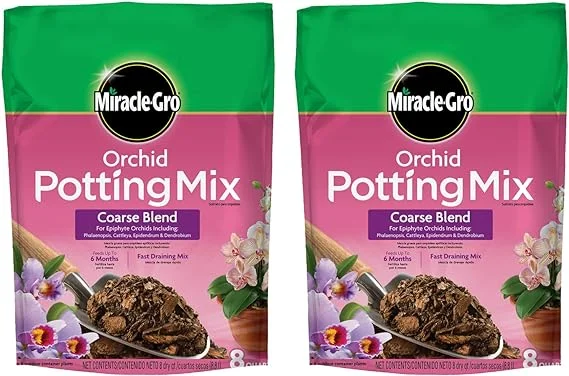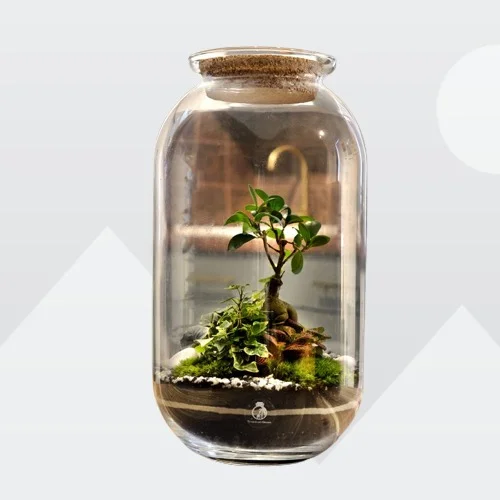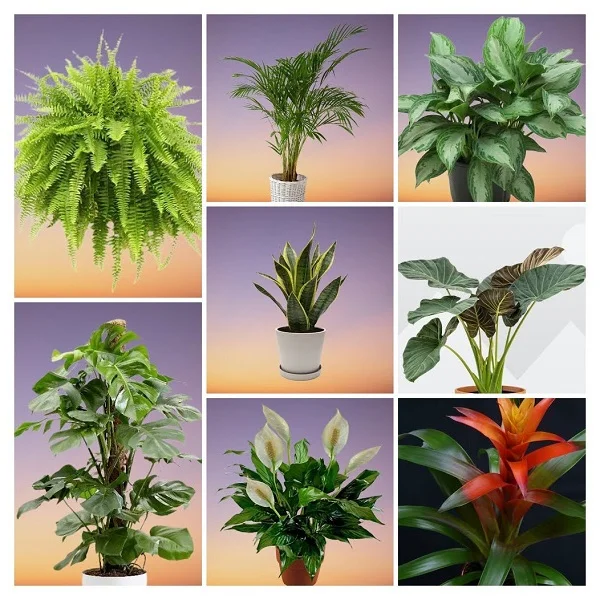Boat Orchids (Cymbidium Orchids) Indoor Care & Propagation Guide for Beginners
Some links in this post may be affiliate links
Boat Orchids (Cymbidium Orchids) flourish in bright indirect light, warm and humid conditions, and moderately moist, rich, well-drained soil coupled with fortnightly feeding in the growing season.
Cymbidium Orchids are among the popular orchids and bears large, waxy, long-lasting flowers arranged on an unbranched flowering stem which arises from the base of the pseudobulb.
The lip (lowermost petal) is significantly different from the other petals and sepals and has three lobes and a spotted center. The shape of the lip gives this orchids their common name, 'Boat Orchids'.
Boat Orchids are prolific bloomers; with several flower spikes bearing up to 100 blooms per season. Some species have thin stems but in most species the stems are modified to pseudobulbs. Where leaves are present, there are 3-12 light-green leaves arranged in two ranks and they last for several years.
The genus name Cymbidium is derived from the Latin name Cymba meaning "cup", "bowl" or "boat" in reference to the shape of the lip (lowest lower petal).
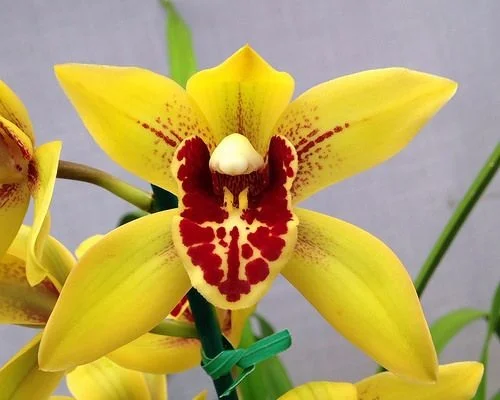
Botanical name: Cymbidium
Family: Orchidaceae
Subfamily: Epidendroideae
Tribe: Cymbidieae
Subtribe: Cymbidiinae
Common name: Boat Orchids
Origin
Cymbidium is a genus of orchids occurring in the wild from tropical to subtropical Asia and Australia.
Varieties
Many cultivars have been developed like the Miniature Cymbidium which is regarded as the beginner's orchid. Cymbidium Orchids flowers are available in red, white, pink, yellow and green.
Are Cymbidium Orchids toxic?
No. Cymbidium Orchids are non-toxic to both humans and pets. They are safe for a home with children, cats, dogs and other pets.
Where to Buy
Are you looking to acquire Boat Orchids? You may obtain these orchids online from Etsy (Link to Etsy).
How to Care for Cymbidium Orchids Indoors
To care for Cymbidium Orchids indoors, give them bright indirect light of about 10 hours per day, warmth of 15-290C, humidity of 50-60% and moderately moist, fertile, well-draining potting soil coupled with fortnightly feeding during the growing season.
Boat Orchids require timely pruning to keep them neat and tidy and also encourage flowering. Repotting is only required when they become extremely pot-bound as they bloom best when root-bound. Keep reading for more on these growing conditions and how to achieve them.
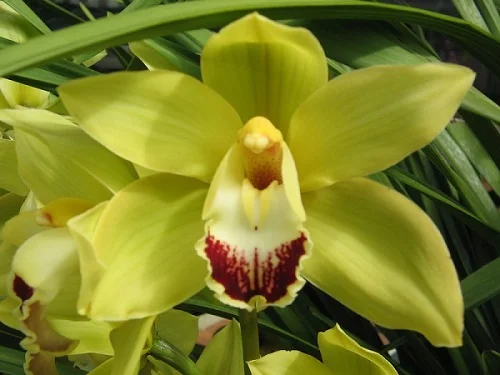
Light Requirements
Do Cymbidium Orchids need full sun?
No. Cymbidium Orchids grow best in bright indirect light of about 10 hours per day. Keep it away from direct sunshine to avoid scorching of the leaves.
A Boat Orchid that is receiving the right amount of light has light yellow-green upright leaves. Dark green leaves indicate that the orchid needs more light. Yellow (more yellow than green) leaves means the orchid is receiving too much light.
Where natural light is not adequate, you may use full spectrum grow lights to maintain a healthy vibrant growth and to prevent change of leaf color.
Regularly turn the pot to ensure that the orchid gets adequate light on all sides for uniform growth and avoid lopsided growth.
Watering
How often should I water a Cymbidium Orchid?
Water your Cymbidium Orchid thoroughly in spring and summer and allow the top half of the potting medium to dry out between waterings. Keep the soil moderately moist but avoid overwatering to prevent rotting and yellowing.
Decrease watering in fall and winter as growth is minimal at this time. Do not allow the medium to dry out completely to prevent wilting, yellowing and browning.
To take the guesswork out of watering, check the roots. Whitish-green and plump roots indicate that the orchid is well hydrated. Whitish, thin roots indicate the orchid needs to be watered.
Use tepid (room temperature) water to prevent cold shock which can result in stunted growth. Ensure that the water is free of chlorine and other dissolved chemicals to prevent browning of leaf edges and tips.
Confirm that the pot has good drainage and the soil is loose and free-draining to prevent rotting. Avoid wetting the foliage to discourage fungal diseases.
Cymbidium Orchids like Cattleya (Corsage) Orchids are more tolerant of dry soil conditions due to the presence of pseudobulbs and their thick leaves. As such take care not to overwater it as it may begin to rot.
Temperature & Humidity
Cymbidium Orchids thrive in a warmth of 15-290C; temperatures that are comfortable for you are ideal for this orchid. The warmer days and cooler night temperatures with a difference of 10-150C are perfect. The cool nights are essential to trigger flowering.
Keep the orchid away from sources of drafts like AC units, windy doors, heat sources, drafty windows to avoid sudden changes in temperature which can result in stunted growth. Maintain good air circulation for the orchid as it cannot tolerate hot and stuffy conditions.
Boat Orchids prosper in a humidity of 50-60%. Where the air is too dry, set the pot on a wet pebble tray or use a cool mist humidifier to raise humidity. Do not mist the leaves to minimize fungal diseases.
Fertilizer
What is the best fertilizer for Cymbidium Orchids?
Feed your Cymbidium Orchids with an orchid's fertilizer every 2 weeks in spring and summer for a lush growth. Ensure to followr the manufacturer's instructions.
Withhold feeding in fall and winter to avoid fertilizer burn (browning of leaf tips and edges) as growth is minimal at this time. Do not feed an orchid that is in flower as it may shorten the flowering period.
It is better to err on the side of underfeeding than overfeeding as overfeeding may result in loss of roots thus death of the orchid. If you overfeed a Boat Orchid, it can also lead to vegetative growth instead of flower production.
Potting Medium
The best potting medium for Cymbidium Orchids should be rich in organic matter, loose and free-draining comprising of bark soil. This is important to prevent it from getting soggy while providing the required nutrients. Most orchid potting mixes are great for these orchids.
Repotting
Cymbidium Orchids bloom best when pot-bound. Repot it only when growth begins to suffer; when the orchid has outgrown its pot and the new growth reaches out over the edge of the pot or when the medium is completely broken down.
Basically repotting a Boat Orchid every 2-3 years should be adequate. Repot only when new growth begins, shortly after blooming is over.
Use a pot with proper drainage holes or slits as the roots need good air circulation. The pot should be only 1 size larger than the current one. Use loose, free-draining bark soil to prevent waterlogging.
Shake off excess soil and trim off any dried and shrivelled pseudobulbs. The large Orchids can be divided to propagate new plants. Take a look at these orchid pots with a free slotted orchid pot liner on Amazon.
Pruning & Grooming
Pruning Cymbidium Orchid entail removal of dead and diseased leaves to keep the plant neat and to reduce pest and diseases infestations. Cut the leaves at the base with a sharp, sterilized scissors or knife to minimize injuries and avoid contamination.
When flowering is over, cut the flower stalk 1 inch above the 3rd node from the bottom to encourage more flower growth.
Occasionally clean the leaves by damp-wiping with a soft cloth to get rid of dust as well as discourage pests and diseases.
How do I get my Cymbidium Orchid to bloom again?
Give the Cymbidium Orchid 6 weeks of cool temperature of about 7-100C during the cold season (fall and winter).
Cut down on watering but maintain the soil moderately moist and withhold feeding during this period.
Take the orchid back to its usual spot when the 6 weeks period is over.
This kind of treatment will coax the Boat Orchid to flower as it mimicks its natural triggers in the wild.
Cymbidium Orchids Propagation
Cymbidium Orchids (Boat Orchids) are propagated from the pseudobulbs at the beginning of the growing season once flowering is over.
Propagating Cymbidium Orchids from the pseudobulbs
- Gently split the pseudobulb into sections and ensure there are at least 3 shoots on each section.
- Seperate the roots attached to each division from the mother root-ball.
- Remove the old potting soil attached to the roots of the sections.
- Select a pot about 1-2 inches larger than the pseudobulb of the section. Make sure that the pot has enough drainage holes and slits to prevent rotting.
- Fill the pot one thirdway with a well-draining orchids soil.
- Position the section in the center of the pot. Bury the roots with the soil while ensuring that the bottom of the pseudobulb is level with the top of the soil.
- Stake each newly potted plant to prevent it from toppling over.
- Water the soil lightly and maintain it slightly moist to enhance root development.
- Place the set up in a warm, well-lit place away from direct sunlight until the section has established its own roots.
- Once well established, move the new orchid to its display position and begin routine care.
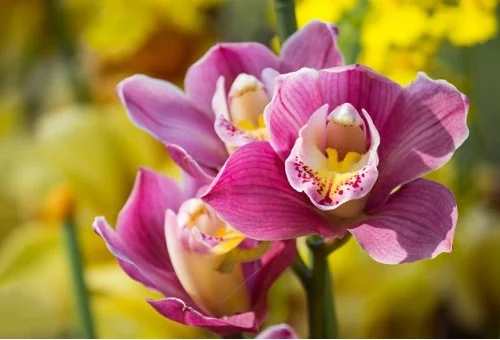
Cymbidium Orchids Problems & Remedies
Cymbidium Orchids (Boat Orchids) problems are yellow leaves, brown leaves, lack of blooms, droopy leaves, pests and diseases among others. Keep reading for more on these problems and how to fix them.
Yellow leaves
Why are my Cymbidium Orchid's leaves turning yellow?
Some of the causes of yellow leaves on your Cymbidium Orchid are too much light, soggy soil, inconsistent watering, drafts, nutrients deficiency or aging.
How to fix it
Too much light: Position the orchid in bright indirect light away from direct sunlight or use a sheer curtain to filter the light.
Soggy soil: Use a chunky, well-draining soil and a pot with slits and proper drainage.
Inconsistent watering: Water when the top half of soil feel dry to the touch but do not allow the soil to dry out completely.
Drafts: Keep the orchid away from sources of drafts like hot air vents, AC units, hot surfaces, windy doors among others.
Nutrients deficiency: Feed the orchid with an orchids fertilizer every 2-3 weeks in spring and summer.
Aging: This is a natural process. As the lower leaves mature, they turn yellow, brown and eventually die.
Brown leaves
The main causes of brown leaves on your Boat Orchids are underwatering, soggy soil extreme temperatures, and fertilizer burn.
How to fix it
Underwatering: Do not water on a schedule. Water when the top half of soil feels dry to touch.
Soggy soil: Use a pot with a drainage hole and well-draining soil.
Extreme temperatures: Keep the orchid away from drafts emanating from AC units, windy doors, heat sources, hot air vents among others.
Salts buildup: Avoid too much fertilizer and do not feed in fall and winter. Flush out excess chemicals from the soil.
Lack of blooms
Lack of blooms on Cymbidium Orchid is caused by too little light, nutrients deficiency, dry air, or lack of temperature variation.
How to fix it
Too little light: Position the orchid in bright indirect light or use a grow light to supplement insufficient natural light.
Nutrients deficiency: Feed the orchid with a water-soluble orchid fertilizer every 2-3 weeks in spring and summer. Do not feed in fall and winter since growth is slowed.
Dry air: Set the pot on a wet pebble tray or use a cool mist humidifier to elevate humidity.
Lack of temperature variation: Expose the orchid to cooler nights to trigger blooming; a difference of 10-150C is needed.
Droopy leaves
Droopy leaves on Cymbidium Orchids are caused by underwatering, temperature stress or exposure to direct sunshine.
How to fix it
Underwatering: Water the orchid when the top half of soil feels dry to the touch. Do not allow the soil to dry out completely.
Temperature stress: Keep the plant away from drafts to avoid temperature flactuations.
Direct sunshine: Move the plant to a more shaded place or use a light curtain to filter the light.
Pests
Common pests on Cymbidium Orchids are spider mites, scales and mealybugs which are prevalent in dry air conditions.
How to fix it
- Isolate the affected orchid to prevent spread to the rest of the plants.
- Treat the orchid with a horticultural oil as per the manufacturers' recommendations.
- Regularly check underneath and between the leaves for these pests and carry out timely control measures.
- Keep the orchid well pruned and raise humidity to depress the pests infestations.
Diseases
Cymbidium Orchids are prone to powdery mildew which presents as white mold on the leaves and is prevalent in stuffy, damp conditions.
How to fix it
- Cut and discard the affected leaves to minimize spread of the disease.
- Do not mist the orchid; set the pot on a wet pebble tray or use a humidifier to increase humidity.
- Ensure that there is good air flow for the orchid to discourage the disease.
- Take care not to wet the foliage during watering.
You liked it? Share on social media.
Related Content
Amazon Associates Disclosure
Homeplantsguide.com is a participant in the Amazon Services LLC Associates Program, an affiliate advertising program designed to provide a means for sites to earn advertising fees by advertising and linking to amazon.com.
